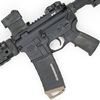-

My reply from another DI vs. Piston discussion on another board:
As a frame of reference I have been hosting 2 to 7 tactical training classes a year, every year since 2000 or 2001. Out side of the classes I host I also take other training classes. I've been a full time Police Officer for 14 years, I've been a SWAT cop for 11 years, and I'm a Firearms Instructor for my agency, our Police Academy, SWAT Team, and SWAT Academy. Prior to that I was in the Marine Corps (Infantry / Security Forces).
In the early 60's when the M16 first came on line there were several important people that wanted to see the M16 fail. So troops were told that they didn't have to clean their guns, they used the wrong powder in the ammo (ie. they were suppose to use stick powder and they used ball powder), etc. By doing this the M16 got a reputation as being an unreliable platform.
In my opinion the reason that the direct impingement gas system (DI) has gotten such a bad reputation in recent years is because people go out an buy low end AR's or they try to build a AR from parts from various manufacturers. They end up with a gun that is unreliable and this feeds into the myth that the DI gas system is unreliable.
When I was in the USMC the main malfunctions were caused from shooting blanks and magazine related. I had seen a hand full of other problems, but they were far and few between.
In the training classes that I host and take on my own and from the AR15's that I see in training and qualification courses at work. Colt, LMT, BCM, Noveske, etc. run well. While CMMG, DPMS, Olympic Arms, Bushmaster, Stag Arms, RRA and others have a high number of reliablity problems.
Piston guns. I have seen a lot of piston guns that have had problems. I have never seen a POF make it through an entire class without problems. About half the Sigs that I have seen have had problems. About 1/3 of the LWRC guns I have seen have had problems.
From my experience piston guns
-have a sharper recoil impulse
-they are heavier
-piston system guns are more expensive
-the different piston systems are new and haven't had the time to be as thouroughly tested as the DI gas system
-many of the piston system operate on a slightly different system
Piston systems on the AR15 is a fairly new concept (most within the last decade). The DI gas system in use on the AR15 has been in service for close to 60 years, this has given engineers time to work the bugs out of the DI system. Not the same can be said for the piston systems used on the AR platform.
In my opinion the piston system is not needed on the AR15 and it exists because guys buy lower end AR15's, many of these lower end AR15's are not reliable, and when a shoorter buys or builds an unreliable AR15 it feeds into the myth that the DI gas system is unreliable. DI gas system AR15's are not created equal. There are different levels of quality.
Pat Rogers has a DI gas system BCM upper that had 26,000 rounds through it before it was ever cleaned. Currently it has just shy of 29,000 rounds on it. Read this article for more info:

03designgroup | BCM Complete AR15 Upper and Lower Receivers 
In short I see no need to buy a piston upper. Buy a QUALITY DI gas system AR15 and use quality ammo, quality magazine, lube it, and it will run without any issues.
Just my .02 cents based on my experience.
 Posting Permissions
Posting Permissions
- You may not post new threads
- You may not post replies
- You may not post attachments
- You may not edit your posts
-
Forum Rules




 Reply With Quote
Reply With Quote
